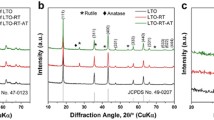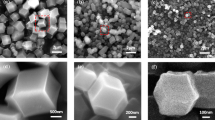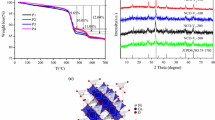Abstract
CoNi-contained nanosheets can be prepared by dealloying CoNiAl alloys in aqueous NaOH solution in the presence of H2O2, and upon annealing sample exhibits dendritic NiCo2O4 micro-nanostructure. The effect of H2O2 solution on the structure, morphology, and electrochemical performances of the resulting products is studied systematically. These results indicate that the H2O2 solution mainly influences the morphology of the NiCo2O4. When tested as anode materials for lithium-ion batteries (LIBs), the obtained NiCo2O4 sample shows high specific capacity, excellent rate property, and superb cycling stability. A reversible capacity is still maintained at 1016.9 mAh/g after 100 cycles at a current density of 100 mA/g. Even at a current rate of 1000 mA/g, the capacity can reach to 691.4 mAh/g. The outstanding electrochemical properties of the NiCo2O4 anode make them promising anode materials of LIBs and other energy storage applications.








Similar content being viewed by others
References
Han X et al (2018) Recent progress of NiCo2O4-based anodes for high-performance lithium-ion batteries. Curr Opinion Solid State Mater Sci 22(4):109–126
Fu F et al (2017) Hierarchical NiCo2O4 micro- and nanostructures with tunable morphologies as anode materials for lithium- and sodium-ion batteries. ACS Appl Mater Interfaces 9(19):16194–16201
Qin B et al (2017) Ultrafast ionic liquid-assisted microwave synthesis of SnO microflowers and their superior sodium-ion storage performance. ACS Appl Mater Interfaces 9(32):26797–26804
Wang J et al (2014) Structural evolution and pulverization of tin nanoparticles during lithiation-delithiation cycling. J Electrochem Soc 161(11):F3019
Kamali AR et al (2011) Tin-based materials as advanced anode materials for lithium ion batteries: a review. Rev Adv Mater Sci 27(1):14–24
Liu Q et al (2019) Double conductivity-improved porous Sn/Sn4P3@ carbon nanocomposite as high-performance anode in lithium-ion batteries. J Colloid Interface Sci 537:588–596
Wetjen M et al (2018) Morphological changes of silicon nanoparticles and the influence of cutoff potentials in silicon-graphite electrodes. J Electrochem Soc 165(7):A1503
Zheng M et al (2018) Hierarchically nanostructured transition metal oxides for lithium-ion batteries. Adv Sci (Weinh) 5(3):1700592
Yuvaraj S et al (2016) An overview of AB2O4-and A2BO4-structured negative electrodes for advanced Li-ion batteries. RSC Adv 6(26):21448–21474
Zhu Y et al (2015) A simple synthesis of two-dimensional ultrathin nickel cobaltite nanosheets for electrochemical lithium storage. Electrochim Acta 176:141–148
Zhou X et al (2015) One-dimensional NiCo2O4 nanowire arrays grown on nickel foam for high-performance lithium-ion batteries. J Power Sources 299:97–103
Zhang C et al (2020) NiCo2O4/biomass-derived carbon composites as anode for high-performance lithium ion batteries. J Power Sources 451:227761
Jain A et al (2019) Two-dimensional porous nanodisks of NiCo2O4 as anode material for high-performance rechargeable lithium-ion battery. J Alloys Compd 772:72–79
Jin R et al (2016) High electrochemical performances of hierarchical hydrangea macrophylla like NiCo2O4 and NiCo2S4 as anode materials for Li-ion batteries. Mater Res Bull 80:309–315
McCue I et al (2016) Dealloying and dealloyed materials. Annu Rev Mater Res 46:263–286
Xu C et al (2010) A general corrosion route to nanostructured metal oxides. Nanoscale 2(6):906–909
Jiang X et al (2015) Dealloying to porous hybrid manganese oxides microspheres for high performance anodes in lithium ion batteries. J Power Sources 274:862–868
Wang Z et al (2017) CoFe2O4 nanoplates synthesized by dealloying method as high performance Li-ion battery anodes. Electrochim Acta 252:295–305
Rong H et al (2018) A novel NiCo2O4@GO hybrid composite with core-shell structure as high-performance anodes for lithium-ion batteries. J Alloys Compd 731:1095–1102
Marco J et al (2000) Characterization of the nickel cobaltite, NiCo2O4, prepared by several methods: an XRD, XANES, EXAFS, and XPS study. J Solid State Chem 153(1):74–81
Xiong S et al (2009) Controllable synthesis of mesoporous Co3O4 nanostructures with tunable morphology for application in supercapacitors. Chem Eur J 15(21):5320–5326
Wang J et al (2017) C@CoFe2O4 fiber-in-tube mesoporous nanostructure: formation mechanism and high electrochemical performance as an anode for lithium-ion batteries. J Alloys Compd 693:110–117
Chen Z et al (2012) Recent advances in manganese oxide nanocrystals: fabrication, characterization, and microstructure. Chem Rev 112(7):3833–3855
Lu Q et al (2013) Ordered mesoporous nickel cobaltite spinel with ultra-high supercapacitance. J Mater Chem A 1(6):2331–2336
Wang Y et al (2010) Excellent performance in lithium-ion battery anodes: rational synthesis of Co (CO3)0.5(OH)0.11H2O nanobelt array and its conversion into mesoporous and single-crystal Co3O4. ACS Nano 4(3):1425–1432
Liu Q et al (2019) Hierarchical mulberry-like Fe3S4/Co9S8 nanoparticles as highly reversible anode for lithium-ion batteries. Electrochim Acta 304:405–414
Chen Z et al (2019) Carbon particles modified macroporous Si/Ni composite as an advanced anode material for lithium ion batteries. Int J Hydrog Energy 44(2):1078–1087
Liu B et al (2019) A three-dimensional multilevel nanoporous NiCoO2/Ni hybrid for highly reversible electrochemical energy storage. J Mater Chem A 7(27):16222–16230
Sun X et al (2014) Multifunctional Ni/NiO hybrid nanomembranes as anode materials for high-rate Li-ion batteries. Nano Energy 9:168–175
Sun X et al (2016) High-defect hydrophilic carbon cuboids anchored with Co/CoO nanoparticles as highly efficient and ultra-stable lithium-ion battery anodes. J Mater Chem A 4(26):10166–10173
Wei Y et al (2015) Solvent-controlled synthesis of NiO–CoO/carbon fiber nanobrushes with different densities and their excellent properties for lithium ion storage. ACS Appl Mater Interfaces 7(39):21703–21711
Sun Y et al (2012) Ultrathin CoO/graphene hybrid nanosheets: a highly stable anode material for lithium-ion batteries. J Phys Chem C 116(39):20794–20799
Li J et al (2013) High electrochemical performance of monodisperse NiCo2O4 mesoporous microspheres as an anode material for Li-ion batteries. ACS Appl Mater Interfaces 5(3):981–988
Hu L et al (2012) CoMn2O4 spinel hierarchical microspheres assembled with porous nanosheets as stable anodes for lithium-ion batteries. Sci Rep 2:986
Mondal AK et al (2014) Highly porous NiCo2O4 nanoflakes and nanobelts as anode materials for lithium-ion batteries with excellent rate capability. ACS Appl Mater Interfaces 6(17):14827–14835
Yang Y et al (2018) Preparation and electrochemical properties of mesoporous NiCo2O4 double-hemisphere used as anode for lithium-ion battery. J Colloid Interface Sci 529:357–365
Liu Q et al (2020) TiO2 particles wrapped onto macroporous germanium skeleton as high performance anode for lithium-ion batteries. Chem Eng J 381:122649
Chen Z et al (2019) Graphene quantum dots modified nanoporous SiAl composite as an advanced anode for lithium storage. Electrochim Acta 318:228–235
Funding
This work was supported by the Natural Science Foundation of Shandong Province (ZR2017BEM020 and ZR2019PB019) and Major Science and Technological Innovation Project of Shandong Province (2019JZZY010457).
Author information
Authors and Affiliations
Corresponding authors
Ethics declarations
Conflict of interest
The authors declare that they have no conflict of interest.
Additional information
Publisher’s note
Springer Nature remains neutral with regard to jurisdictional claims in published maps and institutional affiliations.
Electronic supplementary material
ESM 1
(DOC 1021 kb).
Rights and permissions
About this article
Cite this article
Zhang, M., Li, D., Yang, L. et al. Dendritic micro-nano NiCo2O4 anode material generated from chemical dealloying for high-performance lithium-ion batteries. Ionics 26, 5385–5392 (2020). https://doi.org/10.1007/s11581-020-03726-y
Received:
Revised:
Accepted:
Published:
Issue Date:
DOI: https://doi.org/10.1007/s11581-020-03726-y




